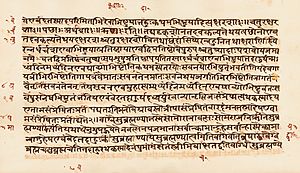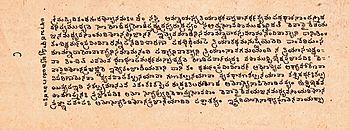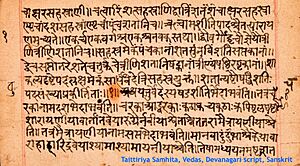Brahmana facts for kids
| Hindu texts |
| Śruti
Smriti |

The Brahmanas (pronounced: BRAH-muh-nuhz) are ancient Sanskrit texts from Vedic times. They are like a second layer of writings found within each of the four Vedas: the Rig, Sama, Yajur, and Atharva Vedas. Think of them as guidebooks that explain the hymns and chants (called Samhitas) found in the Vedas.
These texts help people understand and perform Vedic rituals. They explain the meaning behind the chants and actions. Brahmanas also share some scientific knowledge from the Vedic period, like how people observed the stars (astronomy) and used geometry to build altars. Some Brahmanas even include deep philosophical ideas, which are found in texts called Aranyakas and Upanishads.
Each Veda has its own Brahmanas, and they are usually connected to a specific Vedic school or tradition (called a Shakha). Today, fewer than twenty Brahmanas still exist, as many have been lost over time. Scholars believe the oldest Brahmanas were written around 900 BCE, and the newest ones around 700 BCE.
Contents
What Does 'Brahmana' Mean?
The word Brahmana (or Brāhmaṇam) generally means 'explanations of sacred knowledge'. It can also mean 'Brahmanical explanation,' referring to the Brahmin priests.
According to the Monier-Williams Sanskrit dictionary, 'Brahmana' means:
- 'Explanations of sacred knowledge, especially for Brahmin priests during their sacrifices.'
- 'The part of the Veda that is different from the hymns (Mantra) and philosophical texts (Upanishads). These works contain rules for using hymns in sacrifices, with detailed explanations and old stories.'
A scholar named Sāyaṇa said that Brahmanas have two main parts:
- Vidhi: These are rules or instructions for performing rituals.
- Artha-vāda: These are explanations that praise the rituals, the gods (Devas), and so on.
Where Does the Word Come From?
M. Haug explains that 'Brahmana' comes from the word brahman. This word refers to the Brahma priest who needed to know all the Vedas and understand the entire meaning of a sacrifice. So, the teachings of such an important Brahma priest were called a Brahmana.
Other Names for Brahmana
Some other words that mean similar things to 'Brahmana' include:
- Vyakhyana: This means 'explaining' or 'interpreting'.
- Pravachana: This means 'teaching' or 'oral instruction'.
- Vijnayate: This phrase means 'It is a fact that...' and is used to refer to information from a Brahmana text.
Understanding the Brahmanas
Brahmanas are texts connected to the Samhitas (hymns) of the Rig, Sama, Yajur, and Atharva Vedas. They explain these hymns and guide priests in sacrificial rituals. Brahmanas are written in both prose (like regular sentences) and verse (like poetry).
They are divided into two parts:
- Vidhi: These are commands for performing Vedic rituals.
- Arthavada: These parts praise the rituals and the glory of the gods.
Some scholars believe that the idea of reincarnation (being reborn) and the soul moving between bodies started with the Brahmanas. The Brahmana period ended around 500 BCE, around the time Buddhism began. This period also overlapped with the time of Aranyakas, Sutras, Smritis, and the first Upanishads.
M. Haug explains that the Vedas have two main parts: Mantra (hymns) and Brahmana. The Mantra part contains prayers, invocations to gods, and chants for sacrifices. The Brahmana part always builds on the Mantra part. It explains the meaning of the mantras, gives rules for using them, tells stories about their origins, and reveals their secret meanings.
J. Eggeling notes that Brahmanas are our oldest sources for understanding Vedic rituals. They also give us clues about the earliest philosophical and language ideas of the Hindus. What's really interesting are the many legends and myths found throughout these works. These stories are often told in an old style and appear in different Brahmanas, suggesting they are very ancient.
The Indira Gandhi National Centre for the Arts (IGNCA) explains that while the Upanishads explore the nature of the universe, Brahmanas make these ideas real through a detailed system of rituals (yajna). This system helps remind people how connected humans are to nature, the five elements, and energy sources.
How Rituals Are Performed
Brahmanas are famous for their detailed instructions on performing rituals correctly. They also explain the symbolic importance of sacred words and actions. Scholars like P. Alper and K. Klostermaier say that these instructions demand perfect pronunciation, precise pitch, and coordinated hand movements. Klostermaier mentions that the Satapatha Brahmana says perfect speech makes a mantra powerful, while one mistake can make it useless. This focus on perfection helped preserve the Vedas when writing was not common. Vedic knowledge was taught and memorized by students and passed down through generations.
The Nirukta and Brahmanas
The Nirukta is an ancient text by the grammarian Yāska. It's one of the six Vedangas, which are like "limbs" or helper texts for the Vedas. The Nirukta focuses on the correct meaning and origin of words in the Vedas. It refers to several Brahmanas to help with its explanations:
| Veda | Brahmana | Notes |
|---|---|---|
| Rigveda | Aitareya and Kausitaki | |
| Samaveda | Sadvimsa, Mantra, and Daivata | The Mantra Brahmana is part of the Chandogya Brahmana. |
| Yajurveda | Shatapatha | This Brahmana has two versions: Madhyandina and Kanva. Both are for the Śukla (White) Yajurveda. |
| Taittiriya | This Brahmana is for the Krishna (Black) Yajurveda. | |
| Atharvaveda | Gopatha | This is the only Brahmana that still exists for the Atharvaveda. |
Sayana's Commentaries
Sayana, a Sanskrit scholar from the 14th century, wrote many explanations (commentaries) on Vedic texts, including the Brahmanas. King Bukka asked Sayana to write these commentaries so that even common people could understand the Vedic hymns. Sayana wrote commentaries on many Brahmanas, including:
| Veda | Brahmana |
|---|---|
| Rigveda | Aitareya |
| Samaveda | Panchavimsha, Sadvimsa, Samavidhana, Arsheya, Daivata, Chandogya, Samhitopanishad, Vamsha |
| Yajurveda | Taittirita, Shatapatha (Mâdhyandina version) |
| Atharvaveda | Gopatha |
Brahmanas of the Rigveda
The Aitareya and Kausitaki Brahmanas are the two main ones that still exist for the Rigveda. Some scholars consider the Kausitaki and Samkhyana Brahmanas to be the same text with different names.
Aitareya Brahmana
The sun does never set nor rise. When people think the sun is setting (it is not so). For, after having arrived at the end of the day, it makes itself produce two opposite effects, making night to what is below and day to what is on the other side...In fact, the sun never sets. Nor does it set for him who has such a knowledge. Such a one becomes united with the sun, assumes its form, and enters its place.
The Aitareya Brahmana is believed to have been written down around 600-400 BCE. It is connected to the Shakala school of the Rigveda. This text mainly focuses on the important Soma sacrifices and the ceremonies for crowning kings.
There's a legend about how this Brahmana got its name. An ancient sage had many wives, and one was named Itara. Her son was Mahidasa. The sage favored his other sons and once insulted Mahidasa. Mahidasa's mother prayed to her family goddess, the Earth, who appeared and honored Mahidasa by giving him this Brahmana text as a sign of his great learning. This story is similar to the legend of Dhruva in the Puranas.
Kausitaki / Samkhyana Brahmana
The gods and the Asuras were in conflict over these worlds. From them Agni departed, and entered the seasons. The gods, having been victorious and having slain the Asuras, sought for him...Then indeed did the gods prosper, the Asuras were defeated. He prospers himself, his foe is defeated, who knows thus.
The Indira Gandhi National Centre for the Arts (IGNCA) says the Kaushitaki Brahmana is linked to the Baskala school of the Rigveda. It's also called the Sankhyayana Brahmana. It has thirty chapters and deals with food sacrifices and Soma sacrifices.
A.B. Keith estimates that the Kausitaki Brahmana was written around 600-400 BCE. He believes it is more "scientific" and "logical" than the Aitareya Brahmana. Much of its content, especially the legends, comes from a source common to both it and the Aitareya.
Kaushitaki Brahmana Upanishad
The Kaushitaki Upanishad is also called the Kaushitaki Brahmana Upanishad. It is considered part of the Aranyaka literature, which is often seen as an extension of the Brahmanas.
Brahmanas of the Samaveda
For the Samaveda, there are three main schools or branches: Kauthuma, Ranayaniya, and Jaiminiya.
Panchavimsha / Tandya Brahmana
Visnu is the sacrifice; what here (on this day) is not brought about, that he brings about through Vishnu (who is) the sacrifice.
The Panchavimsha / Tandya Brahmana of the Kauthuma school has 25 books or chapters. It is one of the oldest and most important Brahmanas. It contains many old legends, including the Vratyastoma, a ceremony that allowed people from non-Aryan groups to join the Aryan community.
Sadvimsa Brahmana
The Sadvimsa Brahmana is also from the Kauthuma school. It has 5 chapters and is seen as an appendix to the Panchavimsha Brahmana, like its 26th chapter. It talks about specific formulas and one-day rituals meant to cause harm.
Adbhuta Brahmana
The Adbhuta Brahmana is the last part (5th chapter) of the Sadvimsa Brahmana. It deals with 'omens and supernatural things'.
Samavidhana Brahmana
The Samavidhana Brahmana of the Kauthuma school has 3 books. Its goal is to explain how chanting different hymns (samans) can help achieve certain goals. It is likely older than some of the earliest law books (dharmasastras).
Daivata Brahmana

The Daivata Brahmana of the Kauthuma school has 3 books. It discusses the deities (gods) to whom the hymns are addressed. Its first part is important because it gives rules for figuring out which gods the hymns are for. It also mentions assigning colors to different verses, possibly to help with memory or meditation.
Samhitopanishad Brahmana
The Samhitopanishad Brahmana of the Kauthuma school has 5 books. It talks about the effects of reciting hymns, the connection between the hymns and the words they are chanted on, and the gifts given to religious teachers. It also explains how Rig Vedic verses were turned into Samaveda hymns.
Arsheya Brahmana
The Arsheya Brahmana of the Kauthuma school has 3 books. It is mostly a list of the names of the hymns (samans) found in the first two main collections of the Kauthumas.
Vamsha Brahmana
The Vamsha Brahmana of the Kauthuma school has 3 books. It lists the teachers of the Samaveda. It mentions 53 teachers, with the earliest, Kashyapa, said to have received teachings from the god Agni.
Jaiminiya Brahmana
He should proceed thus: Having taken a water-pot or a water-jar he should go pouring it out from the garhapatya to the ahavaniya with the verse: "Here Visnu strode"...So by water they appease it.
The Jaiminiya Brahmana, also called the Talavakara Brahmana, is from the Jaiminiya school. It has 1348 verses. Many of its sentences are similar to those in other Brahmanas. It also contains many hymns that are new and different from other Vedic texts. This Brahmana was put together by Jaimini, a famous teacher of the Samaveda and a student of Krishna Dvaipayana Vedavyasa.
Jaiminiya Arsheya Brahmana
The Jaiminiya Arsheya Brahmana of the Jaiminiya school is similar to the Arsheya Brahmana of the Kauthuma school. The main difference is that it lists only one sage (rishi) per hymn.
Jaiminiya Upanishad Brahmana
The Jaiminiya Upanishad Brahmana, also known as the Talavakara Upanishad Brahmana, is actually considered an Aranyaka and is part of the Kena Upanishad.
Chandogya Brahmana
Now that light which shines above this heaven, higher than all, higher than everything, in the highest world, beyond which there are no other worlds, that is the same light which is within man.
The Chandogya Brahmana, also called the chanddogyopanishad Brahmana, has ten chapters. Its first two chapters form the Mantra Brahmana, and the remaining chapters (3-10) form the famous Chandogya Upanishad. It belongs to the Kauthuma school.
Mantra Brahmana
|
ad etad dhridayam tava tad astu hridayam mama, |
That heart of thine shall be mine, |
| —Mantra Brahmana, transliteration and translation of Chapter 1, Sukta 3 |
The Mantra Brahmana has two chapters. It mainly provides Vedic Mantras (chants) used in rituals like birth and marriage ceremonies. This text, combined with the Chandogya Upanishad, is also called the Upanishad Brahmana.
One part of the Mantra Brahmana includes hymns for marriage ceremonies. For example, a verse from the marriage pledge says, "That heart of thine shall be mine, and this heart of mine shall be thine." This shows the deep bond the couple promises to share.
Brahmanas of the Yajurveda
Śukla (White) Yajurveda: Shatapatha Brahmana
Mâthava, the Videgha, was at that time on the (river) Sarasvatî. He (Agni) thence went burning along this earth towards the east...He burnt over (dried up) all these rivers. Now that (river), which is called 'Sadânîrâ,' flows from the northern (Himâlaya) mountain: that one he did not burn over. That one the Brâhmans did not cross in former times, thinking, 'it has not been burnt over by Agni Vaisvânara.'
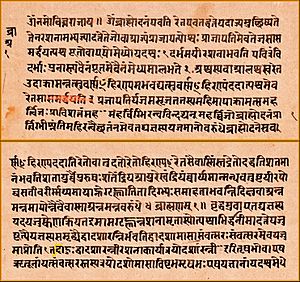
The Shatapatha Brahmana is believed to have been finalized around 1000-800 BCE. However, it talks about astronomical events from as far back as 2100 BCE and historical events like the Sarasvati river drying up around 1900 BCE. It contains scientific knowledge about geometry and observational astronomy from the Vedic period.
This Brahmana is very important for the development of Vaishnavism. It might be where several Puranic legends and avatars of the god Vishnu (like Matsya, Kurma, Varaha, Narasimha, and Vamana) first appeared.
M. Winternitz calls this Brahmana "the best known, the most extensive, and doubtless, also on account of its contents, the most important of all the Brahmanas." It's called Shatapatha, meaning 'of a hundred paths,' because it has a hundred lectures (chapters). It comes in two different versions:
- Mâdhyandina version: This version has 14 books. The first nine books explain the corresponding hymns of the Śukla (white) Yajurveda. The last five books cover newer material, and the very last book is the Bṛhad-Āraṇyaka Upaniṣad.
- Kanva version: This version has 17 books.
Krishna (Black) Yajurveda: Taittiriya Brahmana
When the completion of yajna does not happen in a year (samvatsara) then everything is not stable. Then one has to seek the grace of Vishnu (Vamana) by performing a special rite on the ekadashi day. Yajna means Vishnu (worshipping Vishnu). They perform yajna only for stabilising. They depend on Indra and Agni. Indra and Agni give the abode for Gods (devas). Devas only seek shelter in them and only depend on them.
The Taittiriya Brahmana is linked to the sage Tittiri and the Taittiriya Shakha school. It has three books that explain how to perform Vedic sacrificial rituals, discuss astronomy, and provide information about the gods. The Indira Gandhi National Centre for the Arts (IGNCA) says it's a mix of hymns (mantras) and Brahmana explanations, written in both poetry and prose.
M. Winternitz notes that the Taittiriya-Brahmana of the Black Yajurveda is like a continuation of the Taittiriya-Samhita. This is because the Brahmanas were already included within the Samhitas of the Black Yajurveda. So, the Taittiriya-Brahmana just adds later information to the Samhita.
According to some ancient texts, Tittiri was a student of Yaska (300-400 BCE) or Vaiśampáyana (500-600 BCE).
Vadhula - Anvakhyana
The Vadhula (or Anvakhyana) Brahmana is from the Vadhula school. It's a text that is like a Brahmana, but it's actually part of a larger set of ritual rules called the Vadhula Shrauta Sutra.
Brahmanas of the Atharvaveda
The Atharvaveda has several schools or branches.
Gopatha Brahmana
These (waters) which having encircled the seed, the ocean, rested into (it); those (waters) flowed together towards the east, south, west, and north. In that those (waters) flowed together (towards it), therefore, it is called samudra (ocean). Frightened they said to the lord, alone may we choose as King. And in that having encircled (the ocean), rested into (it), that became Varana. Him who is (really) Varana they call mystically Varuna. Gods are fond of mystical (presentation) as it were, and haters of direct (presentation).
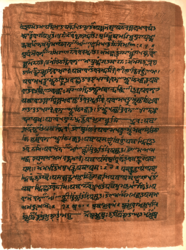
The Gopatha Brahmana is the only Brahmana text that still exists for the Atharvaveda. It belongs to both the Saunaka and Paippalada schools. Its main goal seems to be to include the Atharva Veda in Vedic rituals, making it similar to the other three Vedas.
M. Bloomfield says the Gopatha Brahmana doesn't name its author. It has two parts: the purva-brahmana (five chapters) and the uttara-brahmana (six chapters). The first part is quite original, especially when it praises the Atharvan Veda and its priests. It also touches on ideas found in the Upanishads.
C. Majumdar notes that even though it's called a Brahmana, it actually belongs to the Vedanga literature and is a much later work.
Lost Brahmanas
Many Brahmanas have been lost over time. Scholars like M. Haug say that there must have been many more Brahmanas for each Veda. Even Sayana, who lived about 500 years ago, knew of more Brahmanas than we have today.
S. Shrava explains that countless valuable Vedic manuscripts were lost due to invasions, time, and neglect. If these texts were still available today, there would be less confusion in understanding Vedic hymns. Based on references in other Sanskrit writings, many of these lost works include:
Lost Rigveda Brahmanas
- Paimgi, Paimgya, Paimgayani: Referenced in other Sanskrit texts.
- Bahvricha: Possibly a sub-division related to the Mandukya Upanishad.
- Asvalayana: Possibly the same as the Aitareya Brahmana.
- Galava Brahmana: One of the five Sakala versions of the Rigveda.
Lost Samaveda Brahmanas
- Bhallavi: Referenced in other Sanskrit works.
- Kalabavi: A version of the Samaveda.
- Rauruki: Referenced in other works.
- Satyayana: Referenced by Jayadita.
- Talavakara: Possibly a version of the Jaiminiya Brahmana.
Lost Yajurveda Brahmanas
- Charaka: Main Brahmana of the Charaka version of the Yajurveda.
- Svetasvatara: A sub-division of the Charakas. The Shvetashvatara Upanishad comes from this Brahmana.
- Kathaka: A sub-division of the Charaka version of the Yajurveda.
- Maitrayani: Recorded by the sage Maitrayani.
- Jabala: Recorded by Acharya Mahasala Satyakama Jabala.
- Khandikeya: A division of the Taittiriya school.
- Aukheya: Referenced in the Bhashika Sutra.
- Haridravika: Referenced in Sayana's commentary on the Rigveda.
- Tumburu: A version of both the Yajurveda and Samaveda.
- Ahvaraka: A sub-division of the Charakas.
- Kankati: Referenced in the Apastamba Srauta Sutra.
- Baral: A division of the Mudgal.
- Chhagaleya: A division of the Taittiriya school.
Images for kids
See also
 In Spanish: Bráhmana (texto) para niños Hinduism Vedas Vedic literature Upanishad Samhita Aranyaka Āgama (Hinduism) Shruti Vedanga Upaveda Purana Vedic Period Vedic Sanskrit
In Spanish: Bráhmana (texto) para niños Hinduism Vedas Vedic literature Upanishad Samhita Aranyaka Āgama (Hinduism) Shruti Vedanga Upaveda Purana Vedic Period Vedic Sanskrit




